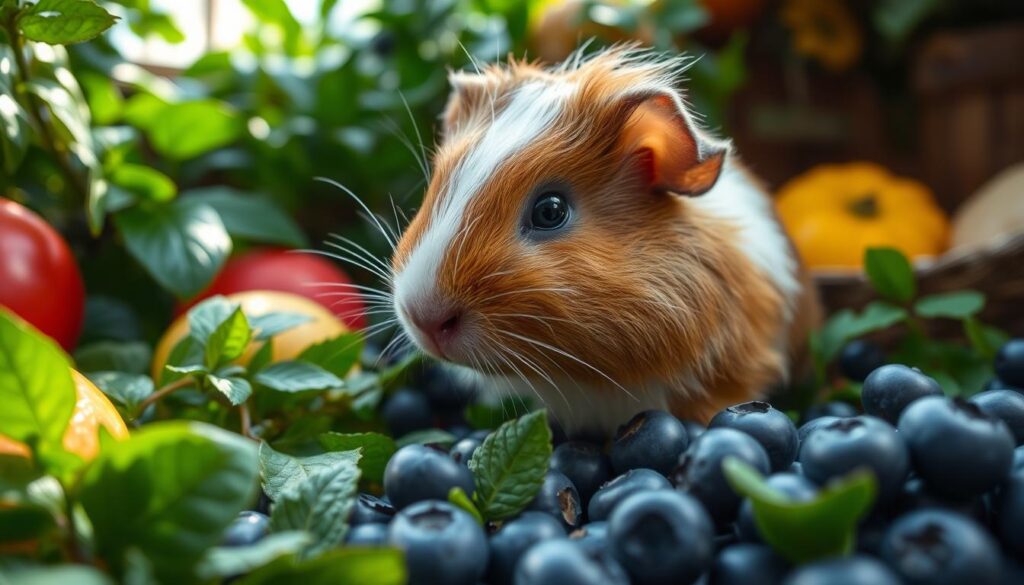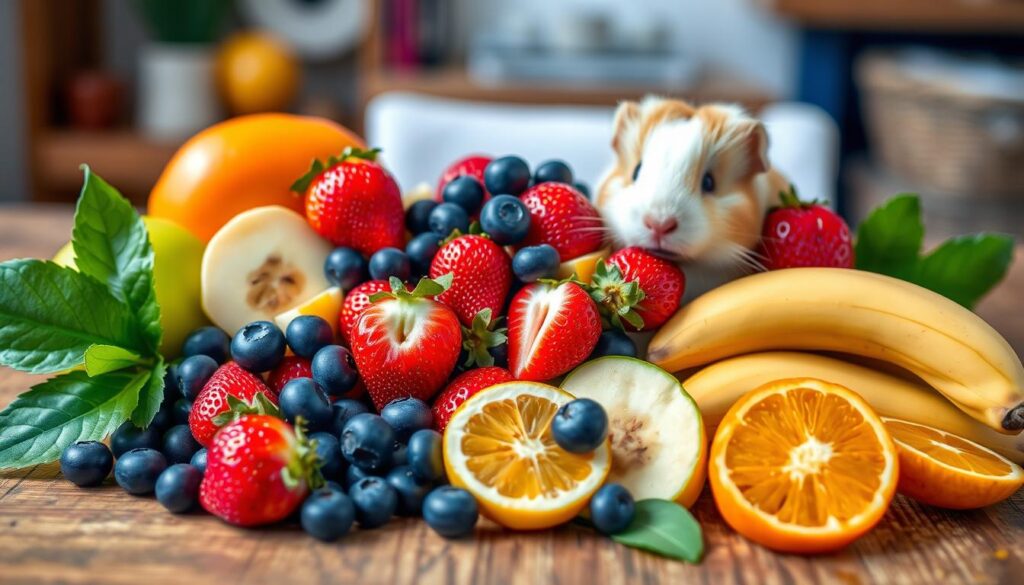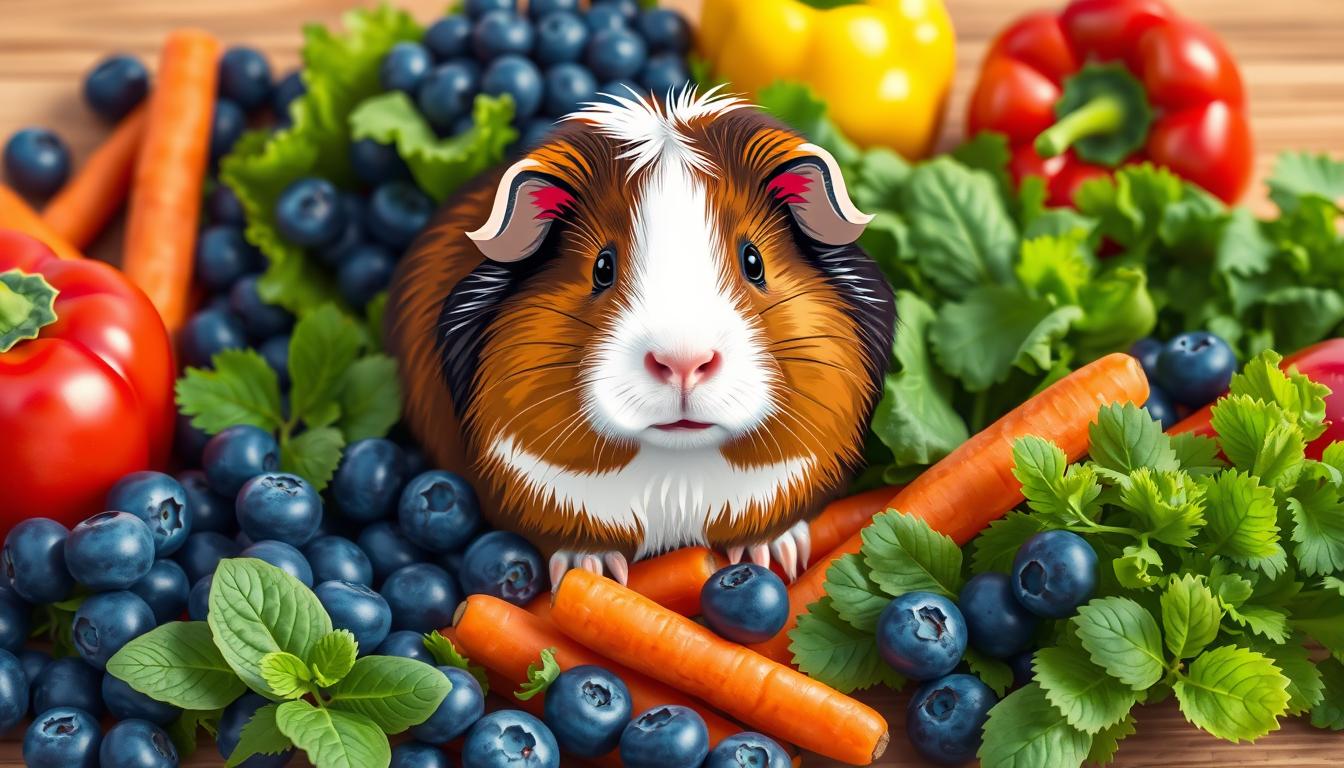As a proud guinea pig parent, I know how crucial a balanced diet is for them. You might wonder if guinea pigs can safely enjoy blueberries. These berries are full of good stuff, but are they safe for our furry friends?
In this guide, we’ll look into feeding blueberries to your guinea pig. We’ll talk about the health benefits, how much to give, and any safety tips. Whether you’re new to guinea pigs or have been caring for them for a while, this article will help you. Let’s explore the answers to your questions together!
Table of Contents
Understanding Guinea Pig Nutrition Basics
Guinea pigs need the right nutrition to stay healthy. As cavies, they have special dietary needs. A balanced diet is key, and fresh foods play a big role in their nutrition.
Essential Dietary Components
Timothy-based hay is the base of a guinea pig’s diet. It should be available all the time, making up 80% of their food. They also need vitamin C-rich vegetables, about 1 cup a day. A small amount of guinea pig pellets, around 2 tablespoons, adds essential nutrients.
Daily Nutritional Requirements
Guinea pigs need specific nutrients every day. They must have fresh, room-temperature water and timothy hay for digestion and dental health. Pellets, which are corn- and seed-free, are a small but important part of their diet, providing vitamins and minerals.
Role of Fresh Foods in Diet
Fresh foods are crucial for guinea pigs because they can’t make vitamin C. Vegetables like bell peppers, kale, and carrots are great sources of vitamin C and other nutrients. Adding different fresh foods ensures a balanced diet, keeps them hydrated, and enriches their lives.
| Dietary Component | Recommended Daily Intake |
|---|---|
| Timothy Hay | Unlimited |
| Vegetables | 1 cup |
| Guinea Pig Pellets | 2 tablespoons |
| Vitamin C | 10-30 milligrams |
“Providing a balanced diet with the right combination of hay, vegetables, and pellets is essential for maintaining the health and well-being of your guinea pig.”
Can Guinea Pigs Eat Blueberries
Yes, guinea pigs can enjoy blueberries as an occasional treat. These berries are packed with vitamins, minerals, and antioxidants. But, it’s crucial to remember to only give them in small amounts because of their sugar content.
Experts at GuineaDad say to only give blueberries 1-2 times a week. Each serving should be just 1-2 small berries. Eating too many can cause weight gain and stomach problems in these sensitive animals.
When introducing blueberries, start with a small amount and watch for any signs of trouble. Some guinea pigs might not like the sugar and acidity in blueberries. So, it’s important to keep an eye out for any allergic reactions or discomfort.
| Fruit | Recommended Frequency | Serving Size |
|---|---|---|
| Blueberries | 1-2 times per week | 1-2 small berries |
| Oranges | 1-2 times per week | 1-2 small slices |
| Dried Berries | Avoid | N/A |
A guinea pig’s diet should mainly include high-quality pellets, fresh greens, and a few safe fruits like blueberries. Adding blueberries in moderation can be a tasty way to keep your cavy healthy and happy.
“Blueberries are one of the healthiest fruits you can feed your guinea pig, but moderation is key. Start with just a couple of berries per week and monitor their reaction closely.”
Health Benefits of Blueberries for Guinea Pigs
Are you wondering if blueberries are good for your guinea pig? The answer is yes, they can be a healthy treat. Just remember to give them in small amounts.
Vitamin C Content
Blueberries are packed with vitamin C, which is great for guinea pigs. They can’t make vitamin C themselves, so they need it from food. This vitamin helps keep your guinea pig’s immune system strong.
Antioxidant Properties
Blueberries also have antioxidants that fight off harmful free radicals. These antioxidants can help keep your guinea pig healthy and reduce inflammation. It’s like a shield for their cells.
Hydration Benefits
Blueberries are also very hydrating, which is perfect for hot weather. They help keep your guinea pig’s body fluids balanced. This is key for their organs to work right.
Even though blueberries are good, don’t overdo it. They have a lot of sugar. Talk to your vet about how much and how often to give them to your guinea pig.
Proper Serving Size and Frequency
Adding blueberries to your guinea pig’s diet should be done with care. Give them one or two blueberries, once or twice a week. Too many can cause obesity and stomach problems because of their sugar.
Start with a small amount of blueberries and watch how your pet reacts. If they like them and don’t have any bad reactions, you can give them more. But do it slowly.
- Limit blueberry portions to one or two small berries per guinea pig
- Offer blueberries as a treat once or twice a week, not daily
- Introduce blueberries slowly and observe your guinea pig’s reaction
- Overfeeding blueberries can lead to obesity and digestive problems
Blueberries are good for your guinea pig, but they shouldn’t be their main food. They need hay, fresh veggies, and a little bit of fruit to stay healthy.
Potential Risks and Considerations
Blueberries can be a tasty treat for your guinea pig. But, it’s key to watch out for risks and allergies. Knowing about blueberry risks and cavies food allergies is important.
Sugar Content Concerns
Blueberries have a lot of natural sugars. Eating too many can cause weight gain and dental issues. Guinea pigs need a diet low in to stay healthy and avoid obesity and diabetes.
Digestive Issues
Introducing new foods, like blueberries, can upset your guinea pig’s stomach. Look for signs of diarrhea or other stomach problems. Stop feeding blueberries if your pet shows any bad reactions.
Signs of Allergic Reactions
Some guinea pigs might be allergic to blueberries. Watch for itching, swelling, or trouble breathing. If you see these signs, stop blueberries right away and talk to your vet.
Feeding blueberries or any fruit to your guinea pig should be done with care. Give small amounts often and watch how your pet reacts. This ensures their safety and happiness.
“Proper feeding and care are essential for the health and happiness of your guinea pig. By understanding the potential risks and taking the necessary precautions, you can safely incorporate blueberries into your pet’s diet and provide them with a delicious and nutritious treat.”
How to Introduce Blueberries to Your Guinea Pig’s Diet
When adding new foods like blueberries to your guinea pig’s diet, do it slowly. Start with a small piece, like a quarter of a blueberry. Watch your pet for 24 hours to see how they react. If they seem fine, you can gradually give them more.
Make sure to wash the blueberries well before giving them to your guinea pig. This removes any bad stuff that could hurt them. After they eat, take away any fruit they didn’t eat. This stops it from getting bad and causing stomach problems.
- Start with a small piece (1/4 blueberry) and observe for 24 hours
- Slowly increase the amount if there are no adverse reactions
- Thoroughly wash blueberries to remove pesticides and contaminants
- Remove any uneaten fruit to prevent spoilage
By following these steps, you can safely add blueberries to your guinea pig’s diet. They’ll get a tasty and healthy treat that’s part of their balanced diet.
“Introducing new foods to your guinea pig’s diet should be done gradually and with care to ensure their health and well-being.”

| Food Item | Recommended Serving Size | Frequency |
|---|---|---|
| Blueberries | 1/4 to 1/2 blueberry | 2-3 times per week |
| Spinach | 1-2 tablespoons | Daily |
| Carrots | 1-2 inch piece | 2-3 times per week |
Fresh vs Frozen Blueberries: What’s Better
Fresh blueberries are the best choice for your guinea pig. They keep more of their natural nutrients and taste. Plus, they’re easier on your cavy’s sensitive stomach.
Frozen blueberries are not good. Freezing can change the fruit’s texture and add harmful bacteria. Some frozen blueberries also have extra sugar and preservatives, which are bad for your guinea pig.
Storage Tips for Fresh Blueberries
- Keep fresh blueberries in the fridge for up to a week.
- Let refrigerated blueberries come to room temperature before giving them to your guinea pig.
- Wash the blueberries well to remove dirt and pesticides.
Preparing Blueberries for Your Guinea Pig
When your blueberries are room temperature, you can prepare them for your guinea pig. Cut big blueberries into smaller pieces. This makes them easier to eat and prevents choking.
“Feeding your guinea pig fresh, nutrient-rich blueberries is a great way to support their overall health and well-being.”
By following these tips, your guinea pig can enjoy fresh blueberries fully. This avoids the risks of frozen blueberries. Always remember to give new foods in moderation.
Other Safe Fruits for Guinea Pigs
Guinea pigs can enjoy many fruits besides blueberries. They can have apples without seeds, strawberries, pears without seeds, melons, and raspberries. But, remember to give them in small amounts because of their sugar.
It’s important to avoid grapes for your guinea pigs. Grapes are too sweet and can be a choking hazard. Always start with a little bit of new fruit and watch how they react.
- Apples (without seeds)
- Strawberries
- Pears (without seeds)
- Melons
- Raspberries
Always give fruits guinea pigs can eat in small amounts. This keeps their diet balanced and healthy. The right amount and how often you give them treats is key for their health.

“A varied and balanced diet is key to keeping your guinea pig happy and healthy.”
Balancing Fruits with Other Food Groups
Feeding your guinea pig right is key. Fruits like blueberries are good for vitamins and antioxidants. But, they should be given in small amounts as part of a full diet plan.
Daily Diet Structure
Hay should be the main food for your guinea pig. It should be available all the time. Hay is about 80% of their diet, giving them fiber and roughage.
Vegetables should make up 15% of their diet. They should eat a variety of leafy greens, crunchy veggies, and sometimes blueberries. Pellets, which are rich in nutrients, should be only 5% of their diet. The right amount is about 2 tablespoons per guinea pig.
Weekly Meal Planning
Planning meals for your guinea pig is important. They need a mix of veggies like bell peppers, carrots, and leafy greens. Fruit treats, like blueberries, should be given only 1-2 times a week. This keeps their diet balanced and prevents health problems.
Remember, a good cavies nutrition plan keeps your guinea pig happy and healthy.


1 thought on “Can Guinea Pigs Eat Blueberries: A Complete Guide”